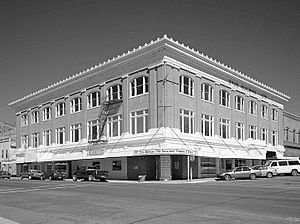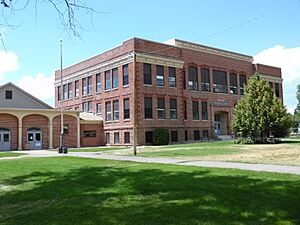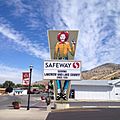Lakeview, Oregon facts for kids
Quick facts for kids
Lakeview, Oregon
|
|
|---|---|
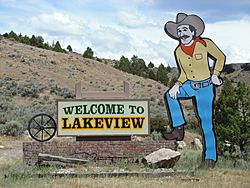
Welcome sign at the north end of town
|
|
| Nickname(s):
The Tallest Town in Oregon
|
|
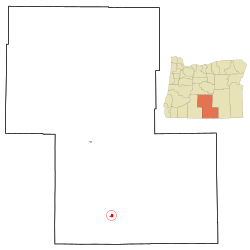
Location in Lake County and Oregon
|
|
| Country | United States |
| State | Oregon |
| County | Lake |
| Incorporated | 1889 |
| Area | |
| • Total | 2.45 sq mi (6.35 km2) |
| • Land | 2.44 sq mi (6.33 km2) |
| • Water | 0.01 sq mi (0.03 km2) |
| Elevation | 4,757 ft (1,450 m) |
| Population
(2020)
|
|
| • Total | 2,418 |
| • Density | 989.77/sq mi (382.15/km2) |
| Time zone | UTC-8 (Pacific) |
| • Summer (DST) | UTC-7 (Pacific) |
| ZIP code |
97630
|
| Area code(s) | 541 |
| FIPS code | 41-40700 |
| GNIS feature ID | 2412870 |
Lakeview is a small town located in Lake County, Oregon, in the United States. In 2020, about 2,418 people lived there. It is the main town and county seat of Lake County.
Lakeview is known as the "Tallest Town in Oregon." This is because it sits very high up, about 4,757 feet (1,450 meters) above sea level. The town is in the Goose Lake Valley, near the Warner Mountains. It is also on the edge of Oregon's high desert area.
The town's economy relies on agriculture, making lumber, and government jobs. Tourism is also becoming more important. The Outback Scenic Byway, a special road for sightseeing, goes right through Lakeview.
Contents
History of Lakeview
Early Inhabitants
People have lived in the area around Lakeview for a very long time. Native American groups were here as far back as 14,000 years ago. This is known from tools and other items found in the Paisley Caves, which are north of Lakeview. When European explorers arrived, Shoshone-speaking people lived in the area.
European Explorers and Settlers
In 1827, Peter Skene Ogden led fur trappers through the Goose Lake Valley. Later, in 1832, John Work also explored the area. Work wrote about the hot springs north of Goose Lake in his journal. These springs are now called Hunter's Hot Springs, about 2 miles (3.2 km) from Lakeview.
In the late 1860s, General George Crook led the U.S. Army in a conflict called the Snake War. He used Camp Warner as a supply base, which was northeast of where Lakeview is today. The camp was closed in 1874.
Founding the Town
The town of Lakeview began in 1869 when M. W. Bullard settled by Bullard Creek. In 1872, William Heryford brought cattle to the valley. The first post office opened nearby in 1873.
Lake County was formed in 1874. In 1876, a vote was held to choose the county seat. M. W. Bullard offered 20 acres (8.1 ha) of land for a courthouse. The town of Lakeview was officially created at a meeting of local residents. Lakeview was chosen as the county seat in a second election in November 1876. Bullard then gave the land, and John A. Moon officially registered the town. The Lakeview post office opened on December 8, 1876.
Growth and Changes
On May 22, 1900, a big fire destroyed most of Lakeview. Sixty-four buildings were lost, but no one died. The town quickly rebuilt, thanks to help from Bernard Daly.
In 1906, the government created the Goose Lake Forest Reserve. It was later renamed the Fremont National Forest in 1908. The forest's main office was in Lakeview.
In 1909, a large land auction brought many people to Lakeview. This helped the county get money for a new brick county courthouse. It replaced the old wooden one.
A narrow gauge railway connected Lakeview to Reno, Nevada, in 1911. This train line helped the town's economy grow. More sawmills opened, making lumber production a big part of Lakeview's business.
In 1913, William P. Heryford built a large, modern building in downtown Lakeview. The Heryford Brothers Building was the biggest and most expensive building in town at the time. It had new features like electric lights and elevators.
By 1940, Lakeview had seven sawmills. These mills helped the town's economy stay strong, especially in winter. Lumber production grew a lot in the 1950s, becoming more than half of the town's economy.
In the mid-1950s, people found uranium in the mountains north of Lakeview. Two mines, White King and Lucky Lass, opened. A plant was built in 1958 to process the uranium. It employed many people but closed in 1961.
In 1985, the Southern Pacific Railroad planned to stop its service to Lakeview. Lake County bought the rail line in 1986. It is now called the Lake County Railroad and still provides freight service.
Geography and Climate
Location and Landscape
Lakeview is located in the Goose Lake Valley. The Warner Mountains are to its east. The town is on the edge of Oregon's high desert. At about 4,800 feet (1,463 meters) high, Lakeview is one of the highest towns in Oregon.
The town covers about 2.34 square miles (6.06 square kilometers). Most of this area is land, with a very small amount of water.
Weather Patterns
Lakeview has a climate that is often dry, like a desert, but with cold winters. Summers are warm during the day, but nights are usually cool. It doesn't rain much in the summer. Winters are cold, and there can be a lot of snow.
Temperatures often drop below freezing (32°F or 0°C) for half the year. Very cold days below 0°F (-18°C) happen about five times a year. The highest temperature ever recorded was 108°F (42°C) in August 1905. The lowest was -27°F (-33°C) in December 2013.
Lakeview gets about 15.49 inches (393 mm) of rain each year. The most rain in one year was 24.13 inches (613 mm) in 1998. The most snow in one month was 53.0 inches (135 cm) in February 1894.
| Climate data for Lakeview 2 NNW, Oregon (1971–2000; extremes since 1888) | |||||||||||||
|---|---|---|---|---|---|---|---|---|---|---|---|---|---|
| Month | Jan | Feb | Mar | Apr | May | Jun | Jul | Aug | Sep | Oct | Nov | Dec | Year |
| Record high °F (°C) | 66 (19) |
69 (21) |
79 (26) |
87 (31) |
96 (36) |
101 (38) |
106 (41) |
108 (42) |
99 (37) |
89 (32) |
79 (26) |
67 (19) |
108 (42) |
| Mean maximum °F (°C) | 51 (11) |
56 (13) |
64 (18) |
73 (23) |
83 (28) |
89 (32) |
95 (35) |
95 (35) |
89 (32) |
80 (27) |
63 (17) |
52 (11) |
96 (36) |
| Mean daily maximum °F (°C) | 37.8 (3.2) |
42.0 (5.6) |
47.9 (8.8) |
55.8 (13.2) |
64.6 (18.1) |
74.0 (23.3) |
83.8 (28.8) |
83.1 (28.4) |
75.1 (23.9) |
62.7 (17.1) |
46.0 (7.8) |
38.6 (3.7) |
59.3 (15.2) |
| Mean daily minimum °F (°C) | 20.6 (−6.3) |
23.0 (−5.0) |
27.8 (−2.3) |
31.6 (−0.2) |
37.6 (3.1) |
44.1 (6.7) |
50.3 (10.2) |
48.4 (9.1) |
41.8 (5.4) |
33.1 (0.6) |
26.0 (−3.3) |
20.6 (−6.3) |
33.7 (1.0) |
| Mean minimum °F (°C) | 0 (−18) |
5 (−15) |
11 (−12) |
19 (−7) |
24 (−4) |
31 (−1) |
39 (4) |
36 (2) |
28 (−2) |
21 (−6) |
11 (−12) |
2 (−17) |
−6 (−21) |
| Record low °F (°C) | −24 (−31) |
−22 (−30) |
−7 (−22) |
2 (−17) |
14 (−10) |
20 (−7) |
26 (−3) |
20 (−7) |
12 (−11) |
0 (−18) |
−14 (−26) |
−27 (−33) |
−27 (−33) |
| Average precipitation inches (mm) | 1.90 (48) |
1.69 (43) |
1.70 (43) |
1.30 (33) |
1.46 (37) |
0.99 (25) |
0.48 (12) |
0.42 (11) |
0.77 (20) |
1.02 (26) |
1.86 (47) |
1.90 (48) |
15.49 (393) |
| Average snowfall inches (cm) | 10.2 (26) |
10.8 (27) |
6.4 (16) |
4.0 (10) |
1.8 (4.6) |
0.1 (0.25) |
0.0 (0.0) |
0.0 (0.0) |
0.2 (0.51) |
1.4 (3.6) |
7.0 (18) |
10.1 (26) |
52 (131.96) |
| Average precipitation days (≥ 0.01 inch) | 11.6 | 10.7 | 11.7 | 9.5 | 8.3 | 5.8 | 3.1 | 2.6 | 4.0 | 6.0 | 10.4 | 11.1 | 94.8 |
| Average snowy days (≥ 0.1 inch) | 5.1 | 4.9 | 3.1 | 2.0 | 0.9 | 0.1 | 0.0 | 0.0 | 0.1 | 0.6 | 3.3 | 5.1 | 25.2 |
| Source: National Oceanic and Atmospheric Administration | |||||||||||||
Population Information
| Historical population | |||
|---|---|---|---|
| Census | Pop. | %± | |
| 1880 | 270 | — | |
| 1890 | 770 | 185.2% | |
| 1900 | 761 | −1.2% | |
| 1910 | 1,253 | 64.7% | |
| 1920 | 1,139 | −9.1% | |
| 1930 | 1,799 | 57.9% | |
| 1940 | 2,466 | 37.1% | |
| 1950 | 2,831 | 14.8% | |
| 1960 | 3,260 | 15.2% | |
| 1970 | 2,705 | −17.0% | |
| 1980 | 2,770 | 2.4% | |
| 1990 | 2,526 | −8.8% | |
| 2000 | 2,474 | −2.1% | |
| 2010 | 2,294 | −7.3% | |
| 2020 | 2,418 | 5.4% | |
| source: | |||
2010 Census Data
In 2010, Lakeview had 2,294 people living in 1,034 households. About 27.5% of households had children under 18. The average age in the city was 43.9 years. About 21.8% of residents were under 18, and 20.2% were 65 or older.
Economy and Jobs
Lakeview's economy is built on farming, lumber, and government work. Raising cattle and growing hay are important local activities. The Fremont–Winema National Forest provides wood for sawmills. The Collins Companies runs a sawmill in Lakeview.
Many people in Lakeview work for the government. This includes people who work for the national forest and the Bureau of Land Management. Tourism is also a growing part of the economy because there are many fun things to do outdoors.
Lakeview is the main town for Lake County. It has schools, a hospital, a sawmill, and many farms. In 2012, the biggest job areas in Lakeview were healthcare, government, farming, and manufacturing.
The Fremont National Forest and the Winema National Forest joined together in 2002. Lakeview became the main office for this combined forest. The Lakeview Interagency Fire Center is also in Lakeview. It helps coordinate efforts to fight wildfires in the area.
A facility called the Warner Creek Correctional Facility opened nearby in 2005. It is about 4 miles (6.4 km) northwest of the city. It employs about 100 people.
Tourism and Recreation
Tourism is a big part of Lakeview's economy. The town is known as the "Tallest Town in Oregon" and is part of the "Oregon Outback." This attracts tourists and outdoor lovers. People come for fishing, birdwatching, camping, hang gliding, paragliding, hiking, rockhounding, and hunting.
Since 1999, Lake County and Lakeview have offered tax help to companies that use renewable energy. This has led to new projects, like a planned facility to turn sawmill waste into electricity.
Recreation and Points of Interest
Outdoor Activities
In the summer, the Fremont–Winema National Forest offers many outdoor activities. The Lakeview District has 22 trails for mountain bike riders and hikers. There are also lakes and streams for fishing, and places for camping and picnics near Lakeview.
In winter, you can go skiing at Warner Canyon Ski Area. It's about 10 miles (16 km) northeast of Lakeview. Snowmobiling is also popular in winter.
Hang Gliding and Paragliding
Lakeview is famous for hang gliding and paragliding. It was even called "the Hang Gliding Capital of the West" in 1991. National championships for these sports have been held in Lakeview many times. The town also hosts a yearly "Festival of Free Flight" around the Fourth of July, which brings pilots from all over the world.
Old Perpetual Geyser
Lakeview is also known for a hot water geyser called Old Perpetual. It is located at Hunter's Hot Springs. Sometimes the geyser stops flowing for a while, usually from September to mid-October. People have different ideas about why this happens, but the exact reason is not known.
Other Interesting Places
Other places to visit include:
- Lake County Museum
- Schminck Memorial Museum
- MC Chuck Wagon Western Heritage Exhibit
- Nevada–California–Oregon Railway Passenger Station (a historic building)
- Heryford Brothers Building (a historic building)
- Post and King Saloon (a historic building)
- Bailey and Massingill General Store (a historic building)
- Lake County Round Sale Barn (a historic building)
- Black Cap vista-point and hang-glider launch-site
- Gearhart Mountain Wilderness
- Abert Rim
- Outback Scenic Byway
Education in Lakeview
Lakeview has its own school district. Lakeview High School serves students in grades 9-12. Daly Middle School, for grades 7-8, is now located at the high school. Lakeview also has two elementary schools: Fremont Elementary (grades K-3) and A.D. Hay Elementary (grades 4-6).
Since 2013, the old Daly Middle School building is used by Klamath Community College. This center allows students in Lakeview to take college classes without having to drive 100 miles (160 km) to the main campus.
Many students from Lake County high schools have received scholarships from the Bernard Daly Educational Fund. This fund was created by Bernard Daly, a doctor, rancher, and politician. He helped over 1,600 students go to college. Daly was known for his bravery. In 1894, he traveled 100 miles in freezing weather to help people after a terrible fire in Silver Lake, Oregon.
Transportation and Services
Getting Around
Lakeview is located on U.S. Route 395 and Oregon Route 140. The Outback Scenic Byway also runs through the town. The nearest cities by road are Klamath Falls, Oregon (96 miles or 154 km west) and Alturas, California (54 miles or 87 km south).
The Lake Railroad provides freight train service from Lakeview to Alturas, California. It is owned by Lake County. The Lake County Airport is about 3 miles (4.8 km) southwest of downtown. It is a public airport with one runway.
Local transportation is available through the Lake County Senior Citizens Association. Their vehicles have ramps for easy access. They serve Lakeview and other nearby towns.
Water Supply
In 2021, the Oregon Legislature approved $15 million for Lakeview to build a new water treatment plant.
Notable People from Lakeview
- Mark W. Bullard, pioneer who donated land to establish town of Lakeview
- Kayte Christensen, color commentator and former professional basketball player
- Charles A. Cogswell, Lake County pioneer, attorney and politician
- Bernard Daly, pioneer doctor, businessman, and politician
- Arthur D. Hay, Oregon Supreme Court Associate Justice
- George W. Joseph, attorney and politician
- Marty Lees, college baseball coach
- Reub Long, rancher and author
- Chuck Mawhinney, Marine Corps sharpshooter
- Stephen P. Moss, rancher, businessman, and state legislator
- Jim Rooker, baseball player
- Jean Saubert, Olympic skiing medalist, Oregon Sports HOF
- Warner B. Snider, state legislator, county commissioner, sheriff, and rancher
- Burt K. Snyder, businessman and state legislator; mayor of Lakeview
- W. Lair Thompson, attorney and politician
- Liz VanLeeuwen, journalist and state representative
- Cobina Wright, actress and opera singer
Images for kids
See also
 In Spanish: Lakeview (Oregón) para niños
In Spanish: Lakeview (Oregón) para niños



